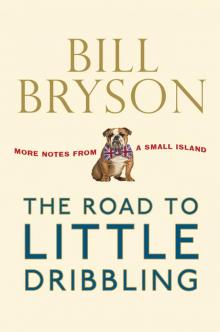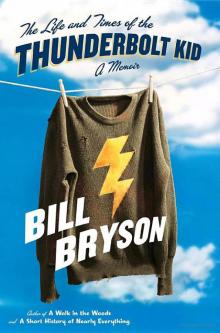- Home
- Bill Bryson
Icons of England Page 7
Icons of England Read online
Page 7
KNEE-DEEP IN A ford, fingers under the stones searching out bullheads; leaping across dry stones where a river should be flowing or standing deep in a dripping cavern singing with glistening towers – it occurs to me that I learnt about happiness and freedom, beauty and the land, from limestone.
My parents loved Derbyshire and whenever time allowed, we were up on the moors or deep in the dales. Already I was being tutored in contrasts – exposed sycamore-embraced farms, valleys and quarries defining each other, the Dark Peak with its summer holiday cotton grass or winter cold edges of millstone grit; the White Peak with its patterns of dry-stone walls and dew ponds. That I should spend my life championing local distinctiveness seems, in retrospect, inevitable.
Limestone is variegated. The pyramid of Thorpe Cloud guards Dovedale – the name alone entices me – and I am still impressed by Peter’s Stone, a coral-reef knoll as big as a church between Wardlow and Litton. It stands surrounded by cropped grass, framed in a streamless cliffed valley. Three hundred and fifty million years ago, fish flew by in a warm sea that was nurturing what we know as carboniferous limestone. This Pennine reef limestone is cemented so tight with fossils and remains that the water finds it hard to penetrate.
It is always a pleasure to bump into fossils: the so-called ‘Purbeck marbles’ are full of shells, and form dark pillars and carvings inside many a church. On polished walls and floors such as those of London’s Festival Hall, you can find the confused patterns of Hopton Wood crinoidal limestone from Derbyshire. And on the beach at Holy Island in Northumberland, you can pick up St Cuthbert’s Beads, the little coins of crinoid stems.
Great underground systems are found in the Mendips in Somerset, and in Derbyshire and Yorkshire. Here too are gorges – enormous at Cheddar and Matlock Bath, narrow but awesome at Gaping Ghyll. Perhaps they are great collapsed caverns, their ice-melt streams shrunken now to little misfits or completely gone, leaving, for example, the high, dry waterfall at Malham Cove. The higher lands are dotted with swallets, sinkholes and waterfalls into netherworlds. Water plays hide and seek, reappearing as risings, springs and boilings in rivers. And in between there is a world of dissolving and dripping, stalactites and stalagmites, calciferous creativity to be chanced upon by cavers, or worn down by the eyes of tourists.
For all the limestones the common thread on the surface is the dry valley, but they do vary. The Mendips fold gently, the Jurassic oolites of the Cotswolds roll. In deep Pennine valleys you can walk along sections of dry riverbeds, as in Lathkill Dale or the Manifold. The situation of villages and farms shows where water is (or was), and in the White Peak of Derbyshire, thanks for water are still given at the well-dressing ceremonies in the high villages.
Our buildings speak most when they tell local stories of the rock beneath. In Portland and Purbeck in Dorset, the variety of limestone beds is used in different ways – local masons and wallers have left a legacy of buildings, roofs and field walls of some substance. And across the country quarries abound. You can see where the houses and walls come from along the ‘limestone belt’ from Portland to Bath, through the Cotswolds, Northamptonshire, Huntingdonshire, Rutland and Lincolnshire.
From mines at nearby Box, Bath stone helps give Bath its honey colour. Buxton, greyer, is wrought of limestone from down the road. But the demand for cement, road stone and aggregate for roads, runways, car parks, harbours and concrete means the Sandford and Dulcote Hills in the Mendips are set to halve in size, demeaning the place and the stone. This makes all the more poignant W. H. Auden’s vision from ‘In Praise of Limestone’:
… but when I try to imagine a faultless love
Or the life to come, what I hear is the murmur
Of underground streams, what I see is a limestone
landscape.
RHYME AND REASON
Wendy Cope
on water meadows
WHEN I FIRST MOVED to Winchester in 1994 and began walking in the water meadows several times a week, I felt as if I had come home to an England I had always loved. That it felt like a homecoming made no sense because I had lived in the London suburbs during my childhood and for most of my life. Perhaps what I came home to was a vision of the perfect English landscape, glimpsed in films and on rural excursions. Here, right on my doorstep, was a landscape that lived up to the vision.
The water meadows are on the southern edge of Winchester, three minutes from the street where I live and ten minutes from the high street. There’s a path through them that runs between two waterways: a millstream known as Logie and the much wider river Itchen. On the first part of the walk, going south, there are fields and trees on the far side of each waterway, and in the distance is St Catherine’s Hill. Everything as far as the eye can see belongs to Winchester College, but the path is open to the public and its dogs.
At some point in the 1980s there was a plan to run the M3 through the water meadows. The headmaster of Winchester and some of his staff attended the public inquiry and made their presence felt by humming. It sounds to me like a risky strategy for schoolmasters – they would have been in trouble if their pupils had borrowed the idea in school. But, eventually, the plan was altered. Despite the best efforts of protesters, the motorway cuts through nearby Twyford Down instead.
If I listen out for it, I can hear some traffic noise on my walks, except when it is drowned by the sound from a culvert or a weir. I also hear birdsong, and, now and then, the humming wings of flying swans. And I often stop to watch the water birds – coots, moorhens, dippers and ducks – going about their business.
The poet John Keats stayed in Winchester for six weeks in 1819. In a letter to his brother he described his daily walk, which took him past the cathedral and along College Street, where – although he wasn’t aware of it – he passed the house where Jane Austen had died two years earlier. Then he followed the path through the water meadows all the way to the ancient almshouse, the Hospital of St Cross, which is still there today. He told a correspondent that ‘there are the most beautiful streams I ever saw, full of trout’. They are still beautiful and you can still see trout in the Itchen.
On his walk on 19 September, Keats was so struck by the beauty of the season and the ‘temperate sharpness’ of the air that he ‘composed upon it’. The result was his ode ‘To Autumn’. It was his last great poem. Already ill, he died seventeen months later, aged twenty-five. It moves me to know that my regular walk is much the same as his, and to reflect on my good fortune in having had so many years to enjoy it.
ALL A BROAD
Nicholas Crane
on the Broads
HANGING ABOVE THE GROCERY shelves in Ludham Bridge Stores is a very strange map. Tubers of sea protrude far inland from a coastline which bears no resemblance to modern topography. Lean over the home-made apple pies and you realize that this is a map of the Great Estuary, the vast tidal waterway which evolved over two thousand years into England’s largest protected wetland: sixty-three shallow lakes and 122 miles of lock-free rivers, spanning two counties and collectively known as the Broads. This secretive water garden is as English as chalk grassland and sooty gritstone, but it is facing change.
Back in the days when Boadicea and her Iceni tribe controlled the Great Estuary, this was a trading haven to rival the Thames. The Iceni capital prospered on one of the estuary’s tendrils and the region’s soils were intensively farmed for grain and sheep. Where yachts tack today between the channel markers on Breydon Water, freight barges scudded over a vast inland sea whose five-mile mouth was defended by the Romans with a pair of gigantic forts. It must have been an extraordinary spectacle; teeming with marine life, its mouth opening on to a glittering inland sea fed by innumerable creeks and rivers.
I grew up close to the Great Estuary’s tributaries. Every morning I’d cycle to school over the river Yare and I remember scrambling through the brambles in the Roman town of Venta Icenorum, long before it was cleared for visitors. At weekends we canoed on the Bure or capsized the family dinghy o
n Hickling Broad. And where I learned to row a coxed-four on Whitlingham Marsh, the towering steel hulls of freighters used to thud upstream towards Norwich, loaded with Baltic timber. Thirty miles from the sea, they looked utterly lost.
The Great Estuary was an environmental accident waiting to happen. After the Romans went home, sea levels fell relative to the land, and the mouth of the estuary silted up. Vast bogs and marshes formed where boats once sailed. It’s a bit unclear when the Broads were formed, but for around four hundred years, through the Middle Ages, some nine hundred million cubic feet of peat were excavated from the region for domestic fuel and for industrial processes such as salt-making. A series of catastrophic inundations and rising sea levels gradually flooded the peat diggings.
Today, this wetland moves me way beyond the reckonings of an amphibious boyhood. Every time I haul the mainsail, I know that the wind will carry our boat into a place where water and land are in a state of precarious balance. This is England’s most impermanent landscape, preserved by pumps and dykes, which cannot keep pace with the rising waters. Science warns that accelerated sea-level rise, the increased likelihood of North Sea surges and violent storms look set to flood many of the acres reclaimed over the last two thousand years. Natural England has estimated that six villages and twenty-five square miles of Norfolk could be lost to the sea within a century. The Broads will become saline. Ecosystems will change. East Norfolk is on the front line of climate change.
So I no longer take for granted the river’s lovely windings past How Hill, or the sight of a wherry heeling by flint-knapped St Benet’s. Sail quietly, and you can see kingfishers, marsh harriers and herons attending the banks in their grey tailcoats. Otters have returned, and there is an alder carr where owls hunt at dusk. On the Broads, there is always the unexpected: a few weeks ago, moored for the night in the lee of a spectral windmill, I went out on deck to silence a slapping halyard, and on tying it back, the sound of a lonely bittern and a faraway church could be heard playing a wetland duet across the starlit flats.
REBUILDING THE PAST
Dan Cruickshank
on the Euston Arch
MY ICON OF ENGLAND is a building that does not currently exist but that lives in the memory and imagination and that could, if we want it to, yet rise from the grave.
Demolished in early 1962 after a short, sharp campaign to save it, the Euston Arch was a London landmark for over 120 years. It was the first major monument of the epoch-making railway age, the centrepiece of Euston Station, which when it opened in 1837 was the first mainline railway terminus built in any capital city in the world. The arch, completed in May of the following year, was the architectural wonder of its time. It was one of the finest Greek-revival buildings in the world – a memorial to the Golden Age of antiquity – yet at the same time a symbol of modernity, of the dawn of a new era of communication and transport. It was also the gate to and from the north, through which flowed the wealth of the land.
The arch, designed by Philip Hardwick, was the largest Greek Doric propylaeum, or gateway, ever built. Standing over seventy feet high, it was a sublime, elemental construction, particularly in its latter years when the granite-hard Bramley Fall gritstone with which it was faced had acquired a silky black patina of soot deposits from steam engines and coal fires.
While the arch was a meticulous copy of muchadmired historic prototypes – notably the Propylaeum of c. 450 BC, which led to the top of the Acropolis in Athens – it was modern in terms of its ingenious and pioneering construction. Although it appeared to be built of traditional masonry, it incorporated much iron. Hardwick wanted to minimize construction costs by reducing the weight of the arch and the quantity of expensive materials employed, so the Bramley Fall gritstone (4,420 tons of it, delivered by rail from Yorkshire) was used to clad a robust iron-and-brick inner structure. For example, each column ‘drum’ was not solid but hollow, being composed of four slabs fixed together with metal clamps and braces.
The failure to save the arch in late 1961 was a bitter and public defeat for the forces of civilization and culture – headed by Sir John Betjeman and the Victorian Society – and a victory for the penny-pinching forces of crude modernization headed by British Railways, aided and abetted by the British government. But the loss of the Euston arch – which appalled the British public – helped to kick-start the conservation movement. Never again it was felt should such a gross act of barbarism be committed in the public’s name, yet against the public’s wishes. And so the sacrifice of the Euston arch helped save the station buildings at St Pancras and King’s Cross, because it was clear to both British Railways and to politicians that such cavalier and brutish conduct could not be repeated.
Public fury was partly due to the fact that most people had assumed that the arch was safe and its future guaranteed. In 1937-8, when the London Midland and Scottish Railway first announced its intention to rebuild Euston Station, the nascent Georgian Group persuaded it to do the decent thing and re-site the arch on the Euston Road. The Second World War put a stop to redevelopment of the station, but when it was discussed again in the late 1950s it was generally assumed that the arch was to be saved. Only in 1960 did it emerge that British Railways and the British Transport Commission wanted to renege on their earlier assurances and save time and money by simply demolishing rather than carefully dismantling and reconstructing the monument. Their betrayal seemed all the more bitter when the Victorian Society demonstrated that moving the arch on rails was technically possible and reasonably cheap.
The final decision on the future of the arch lay with the government and the Prime Minister, Harold Macmillan. Despite intense lobbying from informed individuals and conservation organizations, the government declined to make the British Transport Commission stand by its promise and refused to provide money to move the arch, rejecting advice from the Victorian Society urging that time was pressing. And so, to the intense shock and stunned disbelief of many, demolition took place.
Frank Valori, the man employed by British Railways to demolish the arch, implied soon after destruction that, on his own initiative, he had numbered the stones, dismantled them carefully and stored them. Sadly, this was not true. In the early 1990s two short films about the Euston Arch and its destruction were made for BBC2 and they revealed the arch’s true fate. Demolition was speedy and brutal, with the stones being broken and much damaged as the arch was speedily cleared away. Some of the stones were used by Valori in the construction of his own house – Paradise Villa in Bromley, Kent – although around sixty per cent of them were used to level and ‘armour’ the bed of the Prescott Channel, off the River Lea at Three Mills in Bow, East London. This site was investigated in 1994: one stone slab – part of one of the arch’s column drums – was lifted and is now stored in the garden of a house in Stockwell. Following the discovery of the site of the stones the Euston Arch Trust (EAT) was set up to campaign for the reconstruction of the arch – using as many original stones as possible – at or near Euston Station.
Since 1994 much has happened. The currently proposed redevelopment of the 1960s Euston Station provides a logical opportunity for the reconstruction of the arch at Euston. The location of the Olympic site near Three Mills in Bow has meant the construction of a large new lock on the Prescott Channel and dredging works at and around the location of the stones. These have been conducted with great sensitivity by British Waterways, and led in 2009, with the assistance of EAT, to the location of many more stones and the lifting of twenty-five, including part of a capital of one of the piers, carved entablature and another slab forming part of a column drum.
The issues raised by the campaign to rebuild the arch are complex. A lost building can be rebuilt, but can its spirit be re-created? It is the view of EAT – and its supporters, including English Heritage and the Georgian Group, that by using a large number of original stones, as part of a reconstruction undertaken with conviction and honest intent, the new arch would be more than a shallow pastiche. It woul
d be an act of heroic repair, demonstrating that it is possible to right a great wrong and bring beauty back from a watery grave. If nothing else, EAT’s campaign provokes a profound debate about the nature and role of conservation and the philosophy of repair.
Another debate has to do with the function a reconstructed arch would fulfil if built as an entrance to a redeveloped Euston Station. Should it be made to serve as a practical public building, or should it be simply a symbol?
One thing, however, is clear – now is the arch’s golden chance. Euston Station is scheduled to be redeveloped and the splendid renaissance of neighbouring St Pancras and King’s Cross stations has whetted the public’s appetite for Victorian railway architecture and history, and demonstrates how the old and the new can work together in a most thrilling and creative manner. Reconstruction of the arch would cause delight and wonder around the world, and give a rebuilt Euston character and distinction. For, in the most powerful way possible, it would demonstrate that lost beauty can live again.
FROM THE TRENCHES
General Sir Richard Dannatt
on Breckland
TO THOSE WHO LIVE in Norfolk, it is known as the ‘battle area’. To many soldiers, it is remembered as a very sandy training area, characterized by collapsing trench walls. But Stanford Training Area, located to the north of Thetford, is also the last surviving major piece of English Breckland.
The estate lies in the heart of the Brecks, a place characterized by heathland. This important natural habitat consists of an intimate mosaic of chalk and acid grassland situated in an area with a semi-continental climate – hotter summers, colder winters and considerably less-than-average annual rainfall. Consequently, much of the flora and fauna are unique to the area.

 Notes from a Small Island
Notes from a Small Island A Short History of Nearly Everything
A Short History of Nearly Everything A Walk in the Woods
A Walk in the Woods I'm a Stranger Here Myself
I'm a Stranger Here Myself The Mother Tongue
The Mother Tongue Shakespeare
Shakespeare A Short History of Nearly Everything: Special Illustrated Edition
A Short History of Nearly Everything: Special Illustrated Edition The Best American Travel Writing 2016
The Best American Travel Writing 2016 The Road to Little Dribbling
The Road to Little Dribbling The Life And Times Of The Thunderbolt Kid: A Memoir (v5.0)
The Life And Times Of The Thunderbolt Kid: A Memoir (v5.0) Made In America
Made In America Seeing Further
Seeing Further Shakespeare: The World as Stage
Shakespeare: The World as Stage The Life and Times of the Thunderbolt Kid
The Life and Times of the Thunderbolt Kid At Home
At Home Bryson's Dictionary For Writers And Editors (v5.0)
Bryson's Dictionary For Writers And Editors (v5.0) Neither Here Nor There
Neither Here Nor There Bill Bryson's African Diary
Bill Bryson's African Diary